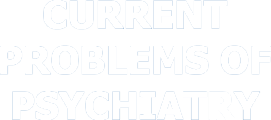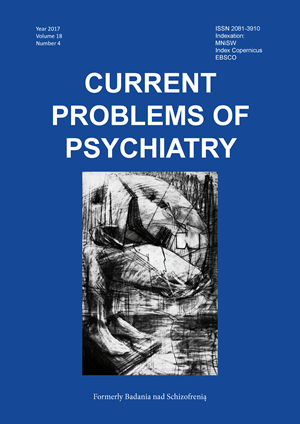Schizofrenia lekooporna i super-lekooporna – studium przypadku
DOI:
https://doi.org/10.1515/cpp-2017-0022Słowa kluczowe:
schizofrenia, klozapina, lekoopornośćAbstrakt
Wstęp: Lekooporność dotyczy około 25% pacjentów leczonych przeciwpsychotycznie, stanowiąc bardzo duże wyzwanie dla klinicystów. Najczęściej akceptowana definicja lekooporności to: brak satysfakcjonującej odpowiedzi klinicznej na leczenie co najmniej dwoma lekami przeciwpsychotycznymi, z różnych grup, prowadzone przy zastosowaniu dawek terapeutycznych i przez wystarczająco długi okres.
Cel pracy: Celem niniejszej pracy jest analiza przypadku pacjenta z rozpoznaniem schizofrenii.
Metody: Analiza dokumentacji medycznej, dostępnego piśmiennictwa ostatnich lat na temat schizofrenii lekoopornej i super-lekoopornej.
Wyniki: Pacjent 53 lata, kawaler, chorujący na schizofrenię paranoidalną o wyjątkowo ciężkim, bezremisyjnym przebiegu z cechami leko-oporności. Ojciec i siostra pacjenta również chorują na schizofrenię paranoidalną o ciężkim przebiegu. Pacjent zachorował w wieku 22 lat. Mimo stosowania wysokich dawek klozapiny, w odpowiednio długim okresie czasu, u pacjenta utrzymywały się objawy pozytywne, negatywne, deficyty poznawcze i zaburzenia zachowania. Chory był 14-razy hospitalizowany psychiatrycznie, dwukrotnie leczony terapią elektrowstrząsową, która nie przyniosła efektów mimo połączenia EW z psychofarmakoterapią. Dodatkowo pacjent był uzależniony od benzodiazepin, podawanych w czasie napadów lęku i niepokoju przez matkę, w czasie opisanej hospitalizacji stopniowo odstawianych. Pacjent po kilku próbach samobójczych, z tendencją do zachowań autodestrukcyjnych. Zoobrazowany przypadek spełnia kryteria schizofrenii super-lekoopornej.
Wnioski:
- Spotykana w piśmiennictwie kategoria schizofrenii lekoopornej nie jest odrębną kategorią diagnostyczną – nie istnieje w systemach klasyfikacyjnych, rozpatrujemy zatem zjawisko/ objaw lekooporności - różnie definiowanej.
- Relacje społeczne mają duży wpływ na funkcjonowanie pacjenta a także przebieg choroby i rokowania (rola rodziny).
- Znane są liczne metody potencjalizacji leczenia klozapiną, spośród których skuteczne i bezpieczne wydaje się łączenie klozapiny z EW. Strategia łączenia leczenia klozapiną z EW jest skuteczna, lecz nie u wszystkich pacjentów.
Bibliografia
1. Jarema M. Leksykon schizofrenii. Poznań; Termedia 2010.
2. Brykalski J., Rajewska-Rager A., Sprawozdanie z IV Szkoły Neuropsychofarmakologii (ECNP), Oxford 2012.
3. Weiden P. J. How many treatments before clozapine? medication-choices across the spectrum of treatment resistance in schizophrenia. The Journal of Clinical Psychiatry, 2016, 77(5), e594.
4. Jarema M. Standardy leczenia farmakologicznego niektórych zaburzeń psychicznych, wyd. II, Gdańsk; Via Medica 2015.
5. Jaracz J. Dodanie leku przeciwpsychotycznego II generacji lub leku przeciwpadaczkowego jako metoda postępowania u chorych na schizofrenię ze słabą odpowiedzią na klozapinę.
6. Sobów T. Klozapina: między skutecznością a bezpieczeństwem. Psychiatria i Psychologia Kliniczna, 2015, 15.2: 57-60.
7. Aamani M., Kalyan K., Somasundara B. "A Study on Efficacy of CLOZAPINE in Treatment Resistant Schizophrenia." International Journal of Scientific Research, 2016, 4.6.
8. Meder J., Tyszkowska M., Jarema M., Araszkiewicz A., Szafrański T. Leki przeciwpsychotyczne w praktyce lekarza psychiatry. Leczenie pacjentów z rozpoznaniem schizofrenii lekoopornej. Psychiatr Pol, 2008, 6, 859-873.
9. Sommer I.E., Begemann M.J., Temmerman A., Leucht S. Pharmacologica laugmentation strategies for schizophrenia patients with insufficient response to clozapine: a quantitative literaturere - view. Schizophrenia bulletin, 2012, 38(5), 1003-1011.
10. Sobów T., Magierski R., Kłoszewska I. Risperidon jako terapia dodana do klozapiny w schizofrenii opornej na leczenie: meta-analiza randomizowanych badań kontrolowanych przy zastosowaniu placebo, 2009.
11. Petrides G., Malur C., Braga R.J., Bailine S.H., Schooler N.R., Malhotra A.K. et al. Electroconvulsive therapy augmentation in clozapine-resistant schizophrenia: a prospective, randomized study. American Journal of Psychiatry, 2014, 172(1), 52-58.
12. Zyss T., Rachel W., Datka W., Hese R.T., Gorczyca P., Szwajca K. et al. Obecne miejsce terapii elektrowstrząsowej. Część 2: Aspekt kliniczny. Przegląd Lekarski, 2015, 72(1).
13. Grochowski M. Gdy klozapina nie wystarcza. Postępy Psychiatrii i Neurologii, 2005, 14: 343-352.
14. Alacam, Huseyin, et al. "miR-181b-5p, miR-195-5p and miR-301a-3p are related with treatment resistance in schizophrenia." Psychiatry Research, 2016, 245: 200-206.
15. Barretto P., Kayo E. M., Avrichir M., Sa B.S., Camargo A.R., Napolitano M.D., I. C. et al. A preliminary controlled trial of cognitivebe-havioral therapy in clozapine-resistant schizophrenia. The Journal of nervous and mentaldisease, 2009, 197(11), 865-868.
16. Kołodziej‑Kowalska E., Rabe‑Jabłońska J. Leczenie schizofrenii elektrowstrząsami oraz lekami przeciwpsychotycznymi, łącznie z elektrowstrząsami. Psychiatria i Psychologia Kliniczna, 2011, 11(4), 238-242.
17. Kupchik M., Spivak B., Mester R., Reznik I., Gonen N., Weizman A. et al. Combined electroconvulsive-clozapine therapy. Clinical neuropharmacology, 2000, 23(1), 14-16.
18. Kho K.H., Blansjaar B.A., De Vries S., Babuskova D., Zwinderman A. H., Linszen, D. H. Electroconvulsive therapy for the treatment of clozapine nonresponders suffering from schizophrenia. Europe-anarchives of Psychiatry and Clinical Neuroscience, 2004, 254(6), 372-379.
19. Raffard S., Bortolon C., Macgregor A., Norton J., Boulenger J. P., El Haj, M. et al. Cognitive insight in schizophrenia patients and their-biological parents: A pilot study. Schizophrenia Research, 2016, 159(2), 471-477.
20. Asarnow R.F., Nuechterlein K.H., Fogelson D., Subotnik K.L., Payne D.A., Russell A.T. et al. Schizophrenia and schizophrenia-spectrum personality disorders in the first-degree relatives of children with schizophrenia: the UCLA family study. Archives of General Psychiatry, 2001, 58(6), 581-588.
Pobrania
Opublikowane
Numer
Dział
Licencja
Prawa autorskie (c) 2017 Autorzy

Praca jest udostępniana na licencji Creative Commons Attribution-NonCommercial-NoDerivatives 3.0 Unported License.


